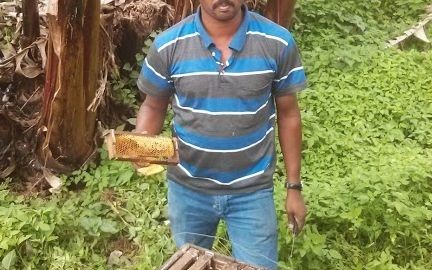I tagged along as a translator with a three students from St. Olaf, USA, who were interested in interviewing PHCC’s resident apiary expert – Kariammal in Thandikudi. He’s a skilled hand at this craft, having received hands-on training on apiary management, with experience in grafting and propagation of bee-hive-in-a-box kits across the region. He was a part of a team that provided training and subsidies to over 900 individuals between 1996-2002, thanks to funds received from an NGO run by Danish beekeepers. We conducted an hour-long interview with him, collected some facts and insights that give a pollinator’s perspective on the bee-colony collapse disorder.
Kariammal provided us with a sampling of Apis Serana Indica honey, fresh out of a box, but accounts are not sweet – honey yields have dropped from 16kgs/Yr per box in 1996, to 2.5 kg/Yr in 2013. The amount of honey produced by a bee-colony is an indicator of its overall health. He attributed the decline to reduced rainfall over the last 2 years, but yields have entered a phase of normalised decline.
Changing agricultural patterns have also worsened the situation – as more and more land in Thandikudi comes under cultivation and productive use, at the expense of the the bees’ habitat. A farmer can make a net profit of 1.25 lacs in 3 months, growing broad beans on half an acre of land. Such intensive agriculture always includes many rounds of pesticide spraying, and these are death traps for the bees, who forage on their flowers due to diminished habitats.
Chemical pesticides used in agriculture are the real bee-killers – especially a class of pesticides known as Neonicotinoids. Studies in the west have conclusively linked Neonicotinoids to the bee colony collapse disorder, a Guardian story calls it the new DDT killing the natural world. While they have been banned in the European union, it is still legal and easily available in the United States and India. A simple Google search yielded dozens of results of manufacturers and distributors of Neonicotinoid class pesticides in India.
Less than 10 percent of the farmers practice organic farming, so the situation seems bleak. The decline of favourable foraging habitats of bees doesn’t just mean no honey – a third of all our food is linked to bees and pollinators, with an estimated annual economic value of 22.51 trillion Indian rupees! The sooner we ban bee-killing pesticides, the better. For more information on this subject, visit sos-bees.org.

